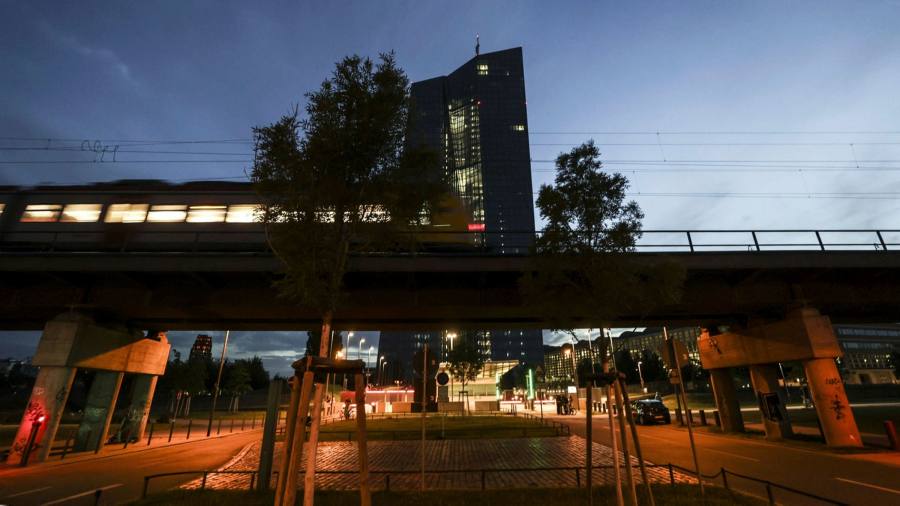
The European Central Bank is looking for ways to prevent banks from making billions of euros in extra profits from the ultra-cheap lending scheme it launched during the pandemic once it starts raising interest rates later this month.
The 2.2 trillion euros in subsidized loans the European Central Bank provided to banks helped avert the credit crunch when the Covid-19 crisis hit. But with the central bank now planning to raise interest rates, it is set to provide a mine of additional profits of up to 24 billion euros to eurozone lenders, according to analysts.
The European Central Bank’s governing council is set to discuss how it can limit the extra margin that hundreds of banks will be able to earn from their subsidized loans once they are returned to deposits at the central bank, according to three people familiar with the plans.
People said it would be politically unacceptable for European Central Bank To provide banks with taxpayer-subsidized profits while raising borrowing costs for households and businesses, most commercial lenders pay bonuses to employees and distribute profits to investors.
The European Central Bank said it intends to Raising the interest rate on deposits to minus 0.25 percent at its meeting on July 21, while the signal for a larger increase in September is likely to rise above zero for the first time in a decade, followed by further increases if inflation remains high.
One option could be for the European Central Bank to change the loan terms to reduce the chance of banks making an automatic return on funds, just as it made them more attractive after the pandemic began in 2020.
The European Central Bank defended its cheap loans to banks, saying: “Without them, the epidemic would have hit the real economy much more.” He declined to comment on how it might prevent lenders from making windfall gains.
Morgan Stanley has estimated that banks could earn between €4 billion and €24 billion in additional profits by putting cheap ECB loans into deposits at the central bank from last month through the end of the scheme in December 2024, depending in part on how quickly rates rise interest in the near future. months.
One person familiar with the matter said that the ECB estimated that the total gains available to banks were half the maximum estimate by Morgan Stanley. More than 740 banks applied For loans at their peak in June 2020, when 1.3 trillion euros were distributed, but the total number of participants in the scheme is not publicly available.
The European Central Bank has started providing loans – known as Targeted Long-Term Refinancing Operations (TLTROs).TLTRO) – in September 2019. Initially it was available at the ECB deposit rate of 0.5%. But after the pandemic hit, the European Central Bank lowered the interest rate to -1 per cent, in effect causing banks to pay more money to borrow money, provided they don’t shrink their loan books.
The European Central Bank returned the TLTRO rate to the deposit rate last month. But crucially, the loan rate is calculated as an average over its three years of life. Banks can repay the money as early as every three months. Last month, €74 billion in early payments were made, much less than expected, reflecting the system’s growing attractiveness as interest rates rise.
“Some banks reviewed their earnings accounts with the ECB, and then gave up on the idea of paying them early,” one official said.
“We expect European banks to hold their TLTROs for as long as possible because they are just free money,” said Fabio Ian, a senior credit officer at Moody’s. He predicted that the bulk of the ECB’s liquidity would not finance the loans but would be deposited in the central bank.
Morgan Stanley has calculated that if the European Central Bank raises the deposit rate to 0.75 percent by the end of this year, the bank that took out the TLTRO loan in June 2020 could make a profit margin of 0.6 percent on the money until it comes due. It is payable in June 2023.
“This trade has been very profitable for us,” said the chief financial officer of a European bank. “It was hard for the banks to scream out loud about that – you don’t want to say that you, as a banker, have been profiting from the pandemic.”
While the European Central Bank does not separate data by banks, French lenders were the largest users of cheap liquidity with exposure of nearly €500 billion in April, followed by their counterparts in Italy and Germany.
At Deutsche Bank, Germany’s largest bank, TLTRO’s €44.7 billion borrowing was equivalent to about 9 percent of its total loan book of €481 billion.
Last year, Deutsche’s interest income was boosted by €494m from ECB-backed liquidity, or 15 per cent of its pre-tax earnings. Deutsche, which considers TLTRO a “government grant” on its accounts, declined to disclose how much was deposited with the ECB.
A person familiar with the bank’s decision-making process said that “mobile commerce for cash was not the purpose of Deutsche Bank’s TLTRO involvement.”

“Web maven. Infuriatingly humble beer geek. Bacon fanatic. Typical creator. Music expert.”





More Stories
Bank of Japan decision, China PMI, Samsung earnings
Dow Jones Futures: Microsoft, MetaEngs Outperform; Robinhood Dives, Cryptocurrency Plays Slip
Strategist explains why investors should buy Mag 7 ‘now’